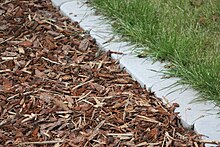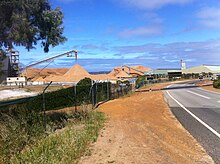Wood gas is a syngas fuel which can be used as a fuel for furnaces, stoves and vehicles in place of gasoline, diesel or other fuels. During the production process biomass or other carbon-containing materials are gasified within the oxygen-limited environment of a wood gas generator to produce hydrogen and carbon monoxide. These gases can then be burnt as a fuel within an oxygen rich environment to produce carbon dioxide, water and heat. In some gasifiers this process is preceded by pyrolysis where the biomass or coal is first converted to char, releasing methane and tar rich in polycyclic aromatic hydrocarbons.

History
Certain stove designs are in effect a gasifier working on the updraft principle—the air passes up through the fuel, which can be a column of rice husks, and is combusted, then reduced to carbon monoxide by the residual char on the surface. The resulting gas is then burnt by heated secondary air coming up a concentric tube. Such a device behaves very much like a gas stove. This arrangement is also known as a Chinese burner.

A wood gasifier takes wood chips, sawdust, charcoal, coal, rubber or similar materials as fuel and burns these incompletely in a fire box, producing solid ashes and soot (which have to be removed periodically from the gasifier) and wood gas. The wood gas can then be filtered for tars and soot/ash particles, cooled and directed to an engine or fuel cell. Most of these engines have strict purity requirements of the wood gas, so the gas often has to pass through extensive gas cleaning in order to remove or convert (i.e. to " crack " ) tars and particles. The removal of tar is often accomplished by using a water scrubber. Running wood gas in an unmodified gasoline-burning internal combustion engine may lead to problematic build-up of unburned compounds.

The quality of the gas from different gasifiers varies a great deal. Staged gasifiers, where pyrolysis and gasification occur separately (instead of in the same reaction zone as was the case in e.g. the WWII gasifiers), can be engineered to produce essentially tar-free gas (less than 1 mg/m³), while single-reactor fluid-bed gasifiers may exceed 50,000 mg/m³ tar. The fluid bed reactors have the advantage of being much more compact (more capacity per volume and price). Depending on the intended use of the gas, tar can be beneficial as well by increasing the heating value of the gas.
It is pointed out, that the gas composition is strongly dependent on the gasification process, the gasification medium (air, oxygen or steam) and the fuel moisture. Steam-gasification processes typically yield high hydrogen contents, downdraft fixed bed gasifiers yield high nitrogen concentrations and low tar loads, while updraft fixed bed gasifiers yield high tar loads.
- Wikipedia

Woodgas flame from a vehicle gasifier unit
History
The first wood gasifier was apparently built by Gustav Bischov in 1839. The first vehicle powered by wood gas was built by Thomas Hugh Parker in 1901. Around 1900, many cities delivered syngas (centrally produced, typically from coal) to residences. Natural gas began to be used only in 1930.
Wood gas vehicles were used during World War II, as a consequence of the rationing of fossil fuels. In Germany alone, around 500,000 " producer gas " vehicles were in use at the end of the war. Trucks, buses, tractors, motorcycles, ships and trains were equipped with a wood gasification unit. In 1942 (when wood gas had not yet reached the height of its popularity), there were about 73,000 wood gas vehicles in Sweden, 65,000 in France, 10,000 in Denmark, and almost 8,000 in Switzerland. In 1944, Finland had 43,000 "woodmobiles", of which 30,000 were buses and trucks, 7,000 private vehicles, 4,000 tractors and 600 boats. Although charcoal was prefer for cars in China during the oil shortages.


A wood gas truck in North Korea.
Wood gasifiers are still manufactured in China and Russia for automobiles and as power generators for industrial applications. Trucks retrofitted with wood gasifiers are used in North Korean rural areas, particularly on the roads of the east coast.
Internal Combustion Engine
Efficiency of the gasifier system is relatively high. The gasification stage converts about 75% of fuel energy content into a combustible gas that can be used as a fuel for internal combustion engines. Based on long-term practical experiments and over 100,000 km drive with a wood gas-powered car, the energy consumption has been 1.54 times higher compared to the energy demand of the same car on petrol (not including the energy needed to extract, transport and refine the oil from which petrol is derived, and not including the energy to harvest, process, and transport the wood to feed the gasifier). This means that 1000 kg of wood combustible matter has been found to substitute 365 litres of petrol during real transportation in similar driving conditions and with the same otherwise unmodified vehicle. This can be considered to be a good result, because no other refining of the fuel is required. This study also considers all possible losses of the wood gas system, like preheating of the system and carrying of the extra weight of the gas-generating system. In power generation reported demand of fuel is 1.1 kg wood combustible matter / kWh electricity.
Wood gasifier on a Ford truck converted into a tractor
Gasifiers have been built for remote Asian communities using rice husk, which in many cases has no other use. One installation in Burma uses an 80 kW modified diesel for about 500 people who are otherwise without power. The ash can be used as Biochar fertilizer, so this can be considered a renewable fuel.
Wood gasifier system
Exhaust gas emission from an internal combustion engine is significantly lower on wood gas than on petrol. Especially the HC emissions are low on wood gas. A normal catalytic converter works well with wood gas, but even without it, emission levels less than 20 ppm HC and 0.2% CO can be easily achieved by most automobile engines. Combustion of wood gas generates no particulates, and the gas renders thus very little carbon black amongst motor oil.
Stoves, Cooking and FurnacesCertain stove designs are in effect a gasifier working on the updraft principle—the air passes up through the fuel, which can be a column of rice husks, and is combusted, then reduced to carbon monoxide by the residual char on the surface. The resulting gas is then burnt by heated secondary air coming up a concentric tube. Such a device behaves very much like a gas stove. This arrangement is also known as a Chinese burner.

Coaxial downdraft gasification stove
An alternative stove based on the downdraft principle and typically built with nested cylinders also provides high efficiency. Combustion from the top creates a gasification zone with the gas escaping downwards through ports located at the base of the burner chamber. The gas mixes with additional incoming air to provide a secondary burn. Most of the CO produced by gasification is oxidized to CO2 in the secondary combustion cycle; therefore, gasification stoves carry lower health risks than conventional cooking fires.
Another application is the use of producer gas to displace LDO (light density fuel oil) in industrial furnaces.
ProductionA wood gasifier takes wood chips, sawdust, charcoal, coal, rubber or similar materials as fuel and burns these incompletely in a fire box, producing solid ashes and soot (which have to be removed periodically from the gasifier) and wood gas. The wood gas can then be filtered for tars and soot/ash particles, cooled and directed to an engine or fuel cell. Most of these engines have strict purity requirements of the wood gas, so the gas often has to pass through extensive gas cleaning in order to remove or convert (i.e. to " crack " ) tars and particles. The removal of tar is often accomplished by using a water scrubber. Running wood gas in an unmodified gasoline-burning internal combustion engine may lead to problematic build-up of unburned compounds.

Fluidized bed gasifier in Güssing, Austria, operated on wood chips
The quality of the gas from different gasifiers varies a great deal. Staged gasifiers, where pyrolysis and gasification occur separately (instead of in the same reaction zone as was the case in e.g. the WWII gasifiers), can be engineered to produce essentially tar-free gas (less than 1 mg/m³), while single-reactor fluid-bed gasifiers may exceed 50,000 mg/m³ tar. The fluid bed reactors have the advantage of being much more compact (more capacity per volume and price). Depending on the intended use of the gas, tar can be beneficial as well by increasing the heating value of the gas.
The heat of combustion of producer gas (a term used in the U.S. meaning wood gas produced for use in a combustion engine) is rather low compared to other fuels. Taylor reports that "producer gas" has a lower heating value of 5.7 MJ/kg versus 55.9 MJ/kg for natural gas and 44.1 MJ/kg for gasoline. The heating value of wood is typically 15-18 MJ/kg. Presumably, these values can vary somewhat from sample to sample. The same source reports the following chemical composition by volume which most likely is also variable:
A charcoal gas producer at the Nambassa alternative festival in New Zealand in 1981
- Nitrogen N2: 50.9%
- Carbon monoxide CO: 27.0%
- Hydrogen H2: 14.0%
- Carbon dioxide CO2: 4.5%
- Methane CH4: 3.0%
- Oxygen O2: 0.6%.
It is pointed out, that the gas composition is strongly dependent on the gasification process, the gasification medium (air, oxygen or steam) and the fuel moisture. Steam-gasification processes typically yield high hydrogen contents, downdraft fixed bed gasifiers yield high nitrogen concentrations and low tar loads, while updraft fixed bed gasifiers yield high tar loads.
- Wikipedia












